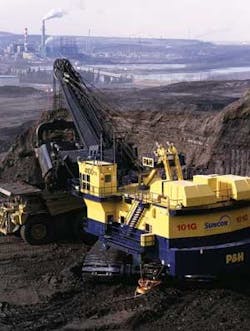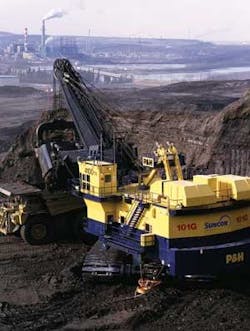How to keep from sinking in Canada’s oil sands
The dos and don’ts of cost reduction in the energy sector
The problem with being “the next big thing” is that something is always threatening to take your place. The Canadian oil sands industry — while not without its critics — has undergone an unprecedented boom in the past few years. Today it’s being heralded as a viable, secure, and lucrative substitute for the world’s dwindling crude oil supplies.
When crude prices began sliding last September, so did the promise of endless prospects and paychecks in Alberta’s oil sands. Now it’s estimated by the Alberta government that energy revenues in the province will fall by more than half this year, to CDN$5.9 billion (just under US$5.2 billion), as a result of continued weak oil prices and a slowdown in industry activity.
Across the entire Canadian oil and gas industry, billions of dollars in capital projects continue to be shelved and natural gas drilling plans are being delayed because of low prices. In the midst of that, almost all oil sands producers have taken steps to remain viable in the tough economic environment. These measures have included trimming their business operations around the edges and, in some cases, carrying out extensive layoffs.
While these short-term measures can contribute to the real need for short-term preservation of capital, Canadian oil and gas companies need to look deeper into the problem and renovate their structures from the inside out. Oil sands developers should be balancing their short-term results with long-term business strategies. In other words, they need to learn to thrive in a world where oil is valued at US$50 to US$60 per barrel, rather than US$100 plus.
An effective cost-optimization program can deliver sustainable results that will continue to flow when economic conditions change.
Improved communication
A strategic cost-optimization plan should begin with improving the timeliness and transparency of communication with major stakeholders. Now is the time to review supply chain and third-party relationships for vulnerability and “fit.” Companies need to review the risk exposure of their major trading partners and determine the potential chain reaction.
Extraction and processing companies should also renegotiate key vendor contracts to achieve more sustainable terms for both parties. Producers should ensure their contractors are in compliance with their contract terms, as overbilling and incorrect billing are far too common.
Protect your company brand and reputation
Opportunities abound for companies with cash. Many oil sands players are well capitalized, with substantial cash reserves. This liquidity advantage will allow them to purchase assets at more attractive prices, create partnerships with less well-capitalized companies, and perhaps even enter into long-term strategic hedging relationships with end users. Those flush with cash should be on the lookout for these opportunities for partnerships and transactions that just weren’t possible a year ago.
All companies, regardless of their financial situation, should perform a comprehensive risk assessment to ensure all key risks are being covered off in the current environment. Boards of directors and management should be full participants in evaluating risk and reward trade-offs.
Improve the efficiency of your operation
Developers in the oil sands need to identify, assess, and restructure toxic and distressed assets and operations. Focusing on core operations and objectives will not only help companies navigate current challenges, it will enable them to emerge stronger once the economy recovers. Now is also the time to accelerate and leverage activities to fund and close financial gaps — for example, through shared services and process improvements.
Human capital: consider your long-term objectives
Until last year, businesses in the oil sands were facing a continuous, severe labor crunch. Not only were labor costs spiraling out of control, labor productivity was simply abysmal. To date, salary costs and other targeted discretionary spending have hit the chopping block as a primary cost-cutting measure.
However, cutting your labor capabilities can open up the risk of poor service or project execution and can negatively impact your business objectives long after the downturn has passed. Oil sands businesses should consider whether the best resources are assigned to the project management initiatives and not diverted to other assignments. They should also maintain effective communication with staff, focus on talent retention where possible, and manage compensation in order to maintain a strong and competent workforce for when the industry bounces back.
The environment
Perhaps the more fundamental disruptive issue to challenge the long-term viability of the oil sands is the environment. Will the Obama administration attempt to impose constraints on Canada’s “dirty oil,” as California recently did? Will greenhouse gas emission-reduction targets cripple the industry’s growth? Is the much-hyped “cap and trade” approach to forcing reductions of GHG emissions even workable? Is access to water — critical to growing oil sands production, especially in steam-assisted gravity drainage (SAGD) projects — an even larger issue?
All of these issues warrant separate discussion, and their financial implications are significant. There is absolutely no doubt that effectively managing the “part real–part perception” challenges surrounding the oil sands and the environment will be complex, and will require oil sands producers to achieve operational excellence and outstanding cost management in order to fund the significant and growing costs of environmental compliance.
Outlook
Is the oil sands’ “golden age” over? Can the industry survive in a US$60 oil price world? Will the environmental agenda derail the industry?
The industry will survive and play a key role in the world energy picture. Fundamentally, the oil sands represent an attractive investment opportunity. Canada has a sound geo-political and fiscal structure. A focus on effective project and cost management, as well as using new technologies to reduce the environmental impact of oil sands development, will allow oil sands players to earn sufficient returns to justify the multibillion-dollar price tags associated with many of the projects.
The global credit crisis — and the resultant severe recession — have certainly reduced global oil demand. But they have also dramatically reduced project-development costs, knocking the oil sands industry out of its seemingly uncontrollable hyper-inflationary spiral.
Although short-term demand has been curtailed, long-term demand for growth in the sector remains strong. It’s estimated that over the next 25 years new oil supplies of 100 million barrels per day may be required to sustain global demand and to replace declining production. While challenges remain in the short term, opportunity knocks for oil sands players who can adjust their business operations to capitalize on new market realities.
About the author
Barry Munro is the managing partner for Ernst & Young in Calgary, the energy industry leader for Ernst & Young in Canada, and is a senior vice president of Ernst & Young Orenda Corporate Finance. He specializes in all facets of corporate finance, including mergers, acquisitions, divestitures, valuations, and financings. Munro’s experience includes board strategy assignments, advising on deal sourcing, valuations, negotiations, and leading multidisciplinary teams of tax, legal, and due diligence professionals.




